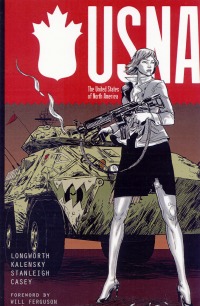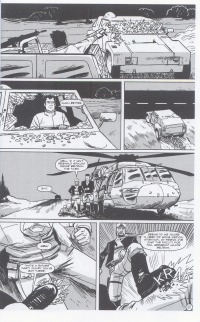| ________________
CM . . .
. Volume XX Number 7. . . .October 18, 2013
excerpt:
In this graphic science fiction/thriller novel, the year is 2025, and the United States and Canada have merged into a single political entity made up of five large states or regions: Pacific, South Central, North Central, Atlantic and Alaskan. At the centre of the story is Carol Wheeler, the widow of Canadian Senator David Wheeler who had been a member of the Cabinet of Prime Minister Samuel Stearn during the period the union of the two nations was being considered. As readers come to learn, Senator Wheeler, a staunch opponent of the idea of a United States of North America and a man with no known heart problems, had died suddenly of a “heart attack”. With Wheeler’s opposition silenced, the merger had moved forward, but the golden age promised by this union has not occurred and a growing resistence movement is creating challenges for those governing the new nation. Carol, a lawyer in a large Toronto law firm, has been largely insulated from the negative changes that had been taking place, but the sudden mysterious death of her elder son, Daniel, leads her to decide to take her other son, Carter, 16, to visit her sister in Calgary in the North Central region. As mother and son motor westward, they are kidnaped by Jean Claude Boivert who identifies himself as a nationalist and a freedom fighter for Canada. From him, Carol learns that Daniel was actually a member of the rebel cause and that Daniel’s death was likely the result of actions taken by the Strategic Home Alliance Defense Organization aka Shado, a covert black ops group that “operate[s] under complete news censorship. Their job is simple. Eliminate all rebel activity by any means, including extreme force where necessary.” Because Carol’s son was part of the rebel cause and because she is identified as being in the company of a wanted “domestic terrorist”, Carol finds that she has also become a target of a Shado manhunt. The book’s bad guy is a former Canadian, the ruthless Commander M. Conrad who has just been recalled from the Cent-Am war to deal with the growing domestic insurgency in the USNA.
A note at the beginning of the book says that “USNA: The United States of North America is based on an original screenplay....” Though the transformation of the screenplay into a graphic novel has largely led to a good read, the work is not without its challenges, many of which might not have been as obvious had the screenplay become a movie for the large or small screen rather than a book. The cast of “participating” characters is huge, and minimally the book could have used a “List of characters” and their roles, perhaps accompanied by visual “mug shots”, to help readers keep track of who’s who. Because there are so many characters, relationships among the characters are sometimes difficult to follow. For me, the most bizarre was that between one of the “terrorists”, O’Brien, and Carol. At one point, while they are on the run, they stop (just once) to have sex. [A note to all you wannabe censors, there are only two panels involving frontal nudity from the waist up. Hardly enough to get your - or a parent’s - shirt or blouse in a knot.] Nothing prior to this event had suggested any growing intimacy between the pair. Further, scene shifts are sometimes difficult to follow and, at times, they demand close attention on the part of the reader. The artwork, rendered in black, white and grey, doesn’t always reflect a scene’s mood as well as full-colour likely would have done. Nonetheless, USNA: The United States of North America will appeal to those senior high students who like to be confronted with the challenge of speculating upon the question of “What if...?” Recommended. Dave Jenkinson, CM’s editor, lives in Winnipeg, North Central Region (aka Manitoba).
To comment
on this title or this review, send mail to cm@umanitoba.ca.
Copyright © the Manitoba Library Association. Reproduction for personal
use is permitted only if this copyright notice is maintained. Any
other reproduction is prohibited without permission.
NEXT REVIEW |
TABLE OF CONTENTS FOR THIS ISSUE
- October 18, 2013.
AUTHORS |
TITLES |
MEDIA REVIEWS |
PROFILES |
BACK ISSUES |
SEARCH |
CMARCHIVE |
HOME |

 The plot is action-packed, with Carol and an ever-growing group of rebels being pursued westward by Conrad’s brutal Shado forces. As any regular reader of thrillers knows, the good guys will win in the end, but the question (and the tension created) is always one of how close the bad guys will come to succeeding. Though adolescent readers will certainly enjoy the plot’s drama, the book’s real appeal resides in the future world created by the authors, including their explanation of how the creation of the USNA came to be. A combination of fear, bullying and bribery led Canada into forming a single nation with the US, and a weak US President, unable to cope with mounting problems, had signed a “Proclamation of Suspension” which “temporarily” allows the military and the secret police to govern without civilian oversight. Instead of the prosperity promised by the establishment of the USNA, “Canadians” now find themselves in a situation of shortages where, for instance, they can only shop every other day. ID cards are required as are travel permits, and police trooper roadblocks on highways are common. Sons are drafted into the military and then become cannon fodder in the USNA’s military attempt to take control of Central America via the Cent-Am war. The family farm becomes a thing of the past, and farmland is controlled either by large corporations or by the government, itself, which has turned the land into prison farms. Citizens, who are now encouraged to address each other as “neighbour”, are also expected to “turn in a clue to a crime, or the whereabouts of a known or suspected criminal...” Those who do so have their names entered into a weekly draw for a million dollars. Of course, “the more clues you enter, the more chances to win.” And reporting someone who speaks against the government qualifies as a “clue.”
The plot is action-packed, with Carol and an ever-growing group of rebels being pursued westward by Conrad’s brutal Shado forces. As any regular reader of thrillers knows, the good guys will win in the end, but the question (and the tension created) is always one of how close the bad guys will come to succeeding. Though adolescent readers will certainly enjoy the plot’s drama, the book’s real appeal resides in the future world created by the authors, including their explanation of how the creation of the USNA came to be. A combination of fear, bullying and bribery led Canada into forming a single nation with the US, and a weak US President, unable to cope with mounting problems, had signed a “Proclamation of Suspension” which “temporarily” allows the military and the secret police to govern without civilian oversight. Instead of the prosperity promised by the establishment of the USNA, “Canadians” now find themselves in a situation of shortages where, for instance, they can only shop every other day. ID cards are required as are travel permits, and police trooper roadblocks on highways are common. Sons are drafted into the military and then become cannon fodder in the USNA’s military attempt to take control of Central America via the Cent-Am war. The family farm becomes a thing of the past, and farmland is controlled either by large corporations or by the government, itself, which has turned the land into prison farms. Citizens, who are now encouraged to address each other as “neighbour”, are also expected to “turn in a clue to a crime, or the whereabouts of a known or suspected criminal...” Those who do so have their names entered into a weekly draw for a million dollars. Of course, “the more clues you enter, the more chances to win.” And reporting someone who speaks against the government qualifies as a “clue.”